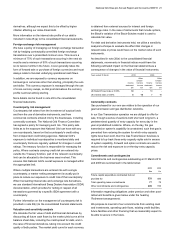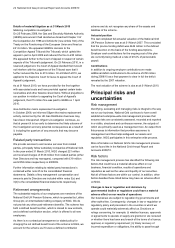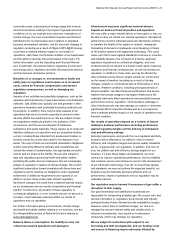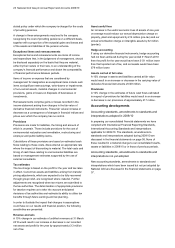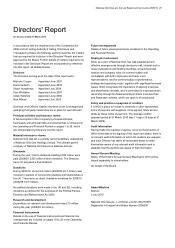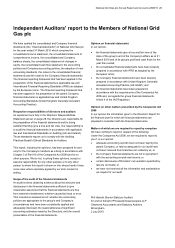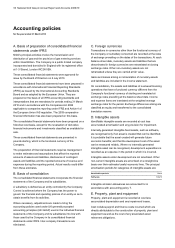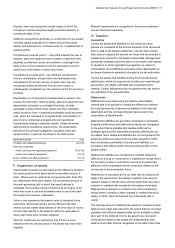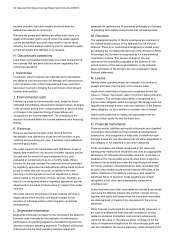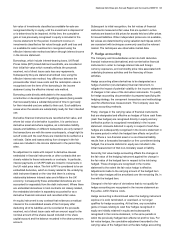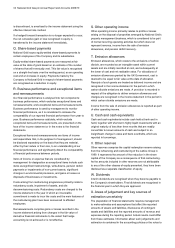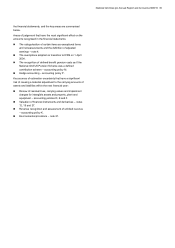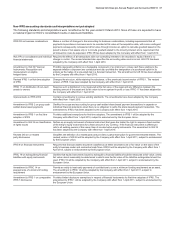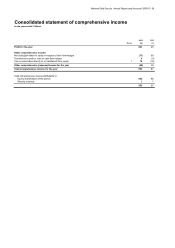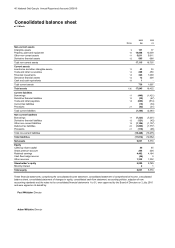National Grid 2010 Annual Report Download - page 32
Download and view the complete annual report
Please find page 32 of the 2010 National Grid annual report below. You can navigate through the pages in the report by either clicking on the pages listed below, or by using the keyword search tool below to find specific information within the annual report.
30 National Grid Gas plc Annual Report and Accounts 2009/10
Accounting policies
for the year ended 31 March 2010
A. Basis of preparation of consolidated financial
statements under IFRS
NGG’s principal activities involve the transmission and
distribution of gas and the provision of gas metering services
within Great Britain. The Company is a public limited company
incorporated and domiciled in England with its registered office
at 1-3 Strand, London WC2N 5EH.
These consolidated financial statements were approved for
issue by the Board of Directors on 2 July 2010.
These consolidated financial statements have been prepared in
accordance with International Financial Reporting Standards
(IFRS) as issued by the International Accounting Standards
Board and as adopted by the European Union. They are
prepared on the basis of all IFRS accounting standards and
interpretations that are mandatory for periods ending 31 March
2010 and in accordance with the Companies Act 2006
applicable to companies reporting under IFRS and Article 4 of
the European Union IAS regulation. The 2009 comparative
financial information has also been prepared on this basis.
The consolidated financial statements have been prepared on a
historical cost basis, except for the revaluation of derivative
financial instruments and investments classified as available for
sale.
These consolidated financial statements are presented in
pounds sterling, which is the functional currency of the
Company.
The preparation of financial statements requires management
to make estimates and assumptions that affect the reported
amounts of assets and liabilities, disclosures of contingent
assets and liabilities and the reported amounts of revenue and
expenses during the reporting period. Actual results could differ
from these estimates.
B. Basis of consolidation
The consolidated financial statements incorporate the financial
statements of the Company and its subsidiaries.
A subsidiary is defined as an entity controlled by the Company.
Control is achieved where the Company has the power to
govern the financial and operating policies of an entity so as to
obtain benefits from its activities.
Where necessary, adjustments are made to bring the
accounting policies used under UK generally accepted
accounting principles (UK GAAP) used in the individual financial
statements of the Company and its subsidiaries into line with
those used by the Company in its consolidated financial
statements under IFRS. Inter-company transactions are
eliminated.
C. Foreign currencies
Transactions in currencies other than the functional currency of
the Company or subsidiary concerned are recorded at the rates
of exchange prevailing on the dates of the transactions. At each
balance sheet date, monetary assets and liabilities that are
denominated in foreign currencies are retranslated at closing
exchange rates. Other non-monetary assets are not
retranslated unless they are carried at fair value.
Gains and losses arising on retranslation of monetary assets
and liabilities are included in the income statement.
On consolidation, the assets and liabilities of overseas financing
operations that have a functional currency different from the
Company’s functional currency of sterling are translated at
exchange rates prevailing at the balance sheet date. Income
and expense items are translated at the weighted average
exchange rates for the period. Exchange differences arising are
classified as equity and transferred to the consolidated
translation reserve.
D. Intangible assets
Identifiable intangible assets are recorded at cost less
accumulated amortisation and any provision for impairment.
Internally generated intangible fixed assets, such as software,
are recognised only if an asset is created that can be identified;
it is probable that the asset created will generate future
economic benefits; and that the development cost of the asset
can be measured reliably. Where no internally generated
intangible asset can be recognised, development expenditure is
recorded as an expense in the period in which it is incurred.
Intangible assets under development are not amortised. Other
non-current intangible assets are amortised on a straight-line
basis over their estimated useful economic lives. The principal
amortisation periods for categories of intangible assets are:
Amortisation periods Years
Software 3 to 5
Intangible emission allowances are accounted for in
accordance with accounting policy T.
E. Property, plant and equipment
Property, plant and equipment is recorded at cost less
accumulated depreciation and any impairment losses.
Cost includes payroll and finance costs incurred which are
directly attributable to the construction of property, plant and
equipment as well as the cost of any associated asset
retirement obligations.



